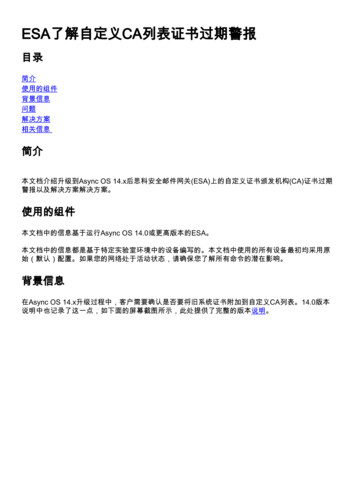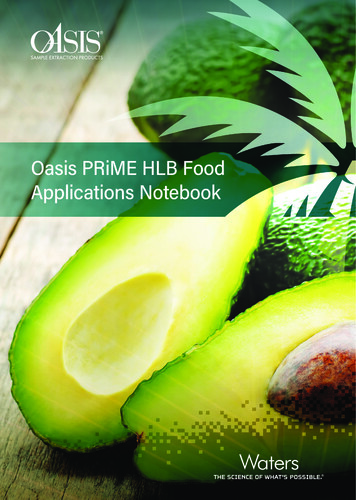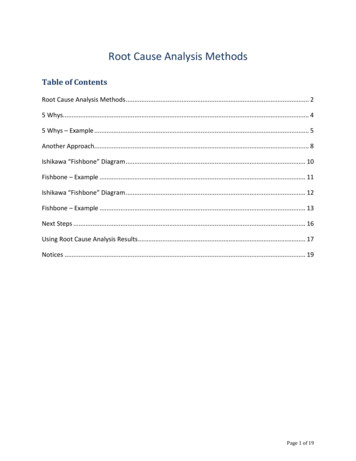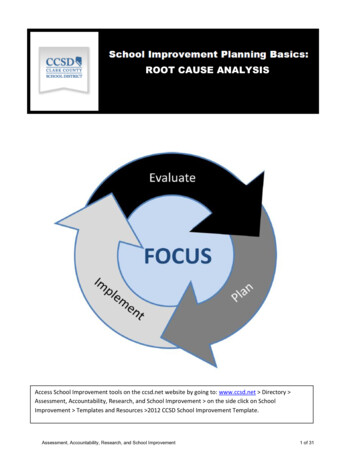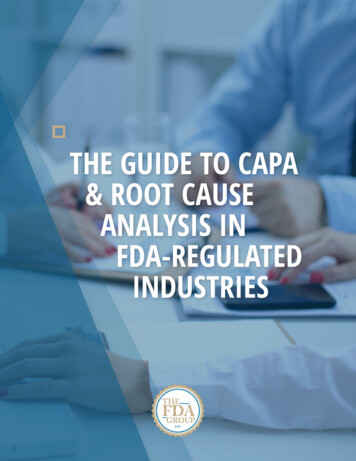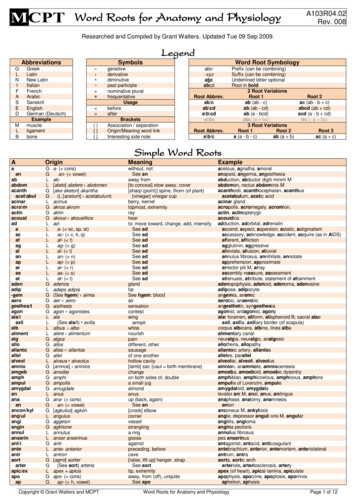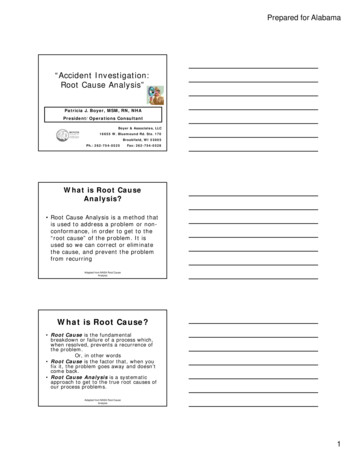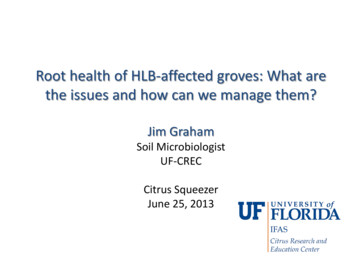
Transcription
Root health of HLB-affected groves: What arethe issues and how can we manage them?Jim GrahamSoil MicrobiologistUF-CRECCitrus SqueezerJune 25, 2013
Current situation and questions aboutHLB expression in FloridaSituation HLB incidence is approaching 100%, especially in young groves Fruit drop statewide has led to a 13% reduction in the USDAcrop estimate (unprecedented ) Most of the Hamlin and Valencia drop appears to be due toHLBQuestion Why is fruit drop greater than in past seasons?
Bacterial infection of the phloem causescarbohydrate disruption and fruit starvation About two months before harvest sugarsmove from the leaves into the fruit suchthat the Brix and the sugar:acid ratioincreases In HLB trees starch accumulates in theleaf cells and disrupts the chloroplasts(leaf mottling) Movement of sucrose from the leaves tothe fruit through the phloem is reduced(sugar:acid ratio may decrease!) Lack of carbohydrate supply causes fruitstarvation and premature drop
Aborted fruit that drop have stem-end break-down
Findings from our recent greenhouse and field studieson root health of HLB-affected trees The bacterium moves to the roots after initial infection/transmission in the shoots The HLB pathogen, Candidatus Liberibacter asiaticus (Las) infectsstructural and fibrous roots Las colonizes the roots before the shoots This infection causes a rapid of fibrous root loss of 27-40% beforesymptoms in the canopy Phytophthora interacts to further reduce root health but themajority of the root loss is due to HLB Phytophthora populations of HLB trees initially increase then asroots are lost due to Las infection, the populations decline rapidly
Phytophthora population in potting soil at 2, 8 and 14 mpi forbud-inoc trees HLB and mock-inoc trees HLB300Propagules / cm3250HealthyHLB2001501005002814Months post inoculation
Statewide drop in Phytophthora counts may reflect theHLB-induced root loss which accelerated fruit drop in 2012-133P. nicotianae (propagules/cm )252015105020082009201020112012Year2012 count based on 2961 samplesData courtesy of John Taylor, Syngenta Crop Protection
Crop loss for HLB symptomatic trees compared tomatched healthy Valencia orange trees on tworootstocks in Hardee Co. from 2009 to 2011*Rootstock Health2009Fruit no.per nce Fruitno. %803-35%6212011Fruit no.per tree5322011Difference777-31%873-23%613-30%*In 2011 measured a 45% reduction in fibrous roots for HLB trees compared to HLBData kindly provided by Davis Citrus Management, Inc.and Magnolia Consulting, Inc.
Soil pH and well water quality may affect roothealth and HLB disease expression Citrus groves often have history of dolomite liming for control ofcopper toxicity and microjet irrigation that concentrates fibrousroots in the wetted zone Soil pH 6.5 and/or well water with bicarbonate ( 100 ppm) areassociated with HLB expression Groves with soil pH 6.5 and/or low bicarbonate water may beexperiencing less deterioration in root health Rootstock sensitivity: Swingle Carrizo Volk Cleopatra Compared 41 grove locations in Highlands and Desoto Countieswith varying liming history and deep vs. shallow wells mostly onSwingle and Carrizo
Survey of well water in central FL citrus grovesDeep wells - pH 7.0 and bicarbonates 100 ppmData from Davis Citrus Management9Water 1McCann ConGlenWeb19MaxSWater 3 TenRhappChamCokeKenMaxNWater 2SmithThreeHenSwanSweetBentMoodySachsWell water pH87ButlerN6Deep wellsButlerSReedy5WalWeigHughColParkerShallow wells4RuvinColeMamaWeb18Steph3050100150Well water bicarbonate200250
Lower root density is related towell water pH 6.5 (r2 0.50 ) and soil pH 6.2 (r2 0.25)Soil pH in the wetted zoneWell water pH1.0Fibrous root density (mg/cm3)Fibrous root density (mg/cm3)1.00.80.60.40.20.03456Well water pH7890.80.60.40.20.04.55.05.56.0Soil pH6.57.07.5
Health and fruit drop status of Valencia/Swingletrees planted in 2003pH 6.4: Fruit drop minimalpH 7.2: Fruit drop resulted in early harvest
Where to go from here?California Central Valley Tour**Sponsored by SyngentaN-furic acid (15-0-0) to adjustwater to pH 6.5e. g. Soil conditioningTiger 90 pelletized sulfur to dropsoil pH from 6.8 to 5.5 (2 yr)7.57.06.5pHe. g. Water conditioning6.0UntreatedTiger 90Pelleted chicken manureBiocontrol agent5.55.068101214161820222426MonthsRidge grove in Lake GarfieldData from L. W. Duncan, CREC
Recommendations Phytophthora, nematodes, weevils should bemanaged more aggressively to sustain roothealth – details in FCPMGwww.crec.ifas.ufl.edu/extension/pest/If Phytophthora count is 10-20 propagules/cm3recommend rotation of fungicides:Aliette/phosphite after spring shoot flushMefanoxam after spring-early summer rainsbeginAliette/phosphite after midsummer shoot flushMefanoxam after fall shoot flushesRemember root flushes follow shoot flushes
Root Flushes and SeasonalPhytophthora ActivitySoil propagules (prop/cm3)605040Spring Shoot FlushShoot FlushShoot FlushFlowering/Fruit Set3020Root FlushRoot FlushFall Root Flush100JanFebMarAprMayJunJulMonthAugSepOctNovDec
Final recommendations Match nutritional supply with tree demand with leaf testing ofthe nutrient status of both HLB and HLB- trees (See CitrusIndustry June, Zekri & Obreza) Balance the costs of root health management with otherresources for HLB, i.e. psyllid control, irrigation and nutritionalprograms, control of other pests and diseases Check status of soil pH in wetted zone and well water for pH,bicarbonates and salinity Investigating whether there is benefit for reducing bicarbonatesby acid treatment of irrigation water and/or amending soil withS to lower pH (collaboration with Kelly Morgan, SWFREC)
Canker Bacteria DisseminationBacteria becomeincorporated into raindroplets and aredisseminated byrainstorms, TropicalStorms and HurricanesWind driven Rainstrikes foliage withcanker lesions
High levels of canker losses occur depending on cultivar,leafminer, timing of wind-blown rain events w/ fruit size
Site conditions that promote canker arewide areas without natural windbreaks
Frequent and vigorous flushes on young treeswith leafminer combined with wind exposurepromotes canker even on resistant Valencia
Period of greatest fruit susceptibility Occurs when the fruit reaches 0.25-0.5 inches in diameteruntil fruit is about 1.5 inches in diameterRains in April-May promote early season infectionThe rind is susceptible throughout the entire period of fruitgrowth, but becomes more resistant with time
Challenges posed by Hamlins forcanker control Hamlin is the most susceptible sweet orange cultivars andcomprises 50% of FL orange cropPreviously, copper fungicide was applied to Hamlin 1-2 timesper season to control greasy spotTo control canker, additional copper sprays at 21 day intervalare required for optimal cost/benefit (Behlau et al. 2009)In young groves number of copper sprays increasesHow many additional sprays are necessary?What rates and copper formulations are effective?
Integrated management doesn’t solely rely on coppersprays for inoculum control Hedgerows act as internal windbreaks/for reducingwind speed Citrus leafminer control is essential Copper sprays with metallic rates that are effectiveand minimize copper loading Systemic control of bacterial infection with soil appliedneonicotinoids and Actigard as SAR inducers
2012: dry spring, wet late summer-early fallSebring Rainfall10201210-yr averageRainfall (inches)86420Mar.AprilMayJuneJulyAug. Sept.Oct.Nov.
Formulations, rates and manufacturers of products testedTreatmentManufacturer/supplierMetallic Cu(%)1) Kocide 20002) Kocide 30003) Nordox4)Nordox Magna-Bon (MB)5)Nordox 3 apps, MB 2apps6) Champ 30WP7) NuCop 50HB8) Quimetal cuprous oxide9) Quimetal Cu hydroxide10) Badge X211) Americop 40 DF12) Cop-R-Quik13) Cop-R-Quik14) Magna-Bonz - 5 ughQuimetalQuimetalIsagroIQVNat.Ag. Sol.Nat.Ag. tallic(lb or oz/acre) 2.0 oz0.2816.0 oz0.3792.8 oz0.3515) Magna-Bonz -7 appsMagna-Bon592.8 oz0.3516) Magna-Bony17) Untreated check 1(UTC)18) Untreated check 2(UTC)Magna-Bon---5---74 oz---0.28---z 250yppm, 200 ppm, 150 ppm and 100 ppm for rest of applications200 ppm for all apps
% fruit with cankeroldnew80ab ababaaab60ababab ababaabaababb40200Cumulative fruit drop with cankeraNordoKoNo x crd MK o i deox agci 20/ M nadag -B N e 3 00na on o 00 4 l-B .4 rdo 0 b/aon 4 l x 3.4 b/a 1.3 lb/a4 3lb 1 lb/a 0 /aQ Qui 0pui m10 pmm eCet taham 0ppal l cco up N p mpp ro uC 3ler us op b/aoMBa hyd xid 2lbagro e /adnM ag xi 2lag -BAm e X de b/ana on3C er 2 2 lb-B 25op ic .6 /aon 0o 825 ,20 Co R Q p 2 lb/0, 0,1 p u .5 a20 5 R ik lb0, 0,1 Qu 12 /a15 0 i k o0, 0 p 1 z/aM 100 pm 6 oag p 5 z/ana pm a-B 7 ppon a s20 pp0p spmUTCUTCNordoKN x ocor Mdo aK i deoc 2x/ gni d 00M ae 0ag -BNna on o 300 4 l-B .4 rdo 0 b/aon 4 l x 3.4 b/a 1.3 lb/a4 3lb 1 lbQ/a 0 /aQ ui 0pui m1 pm eCet taha 00p mal l cco up N mp pmpp ro uC 3ler us op b/ahy ox 2MBagd id lbadg rox e 2 /aM nai lag -BA e X de b/ana onm 2 3C er 2 lb-B 25op ic .6 /aon 0o 8,25 20 Co R Q p 2 lb0, 0,1 p u .5 /a20 5 R ik lb0, 0,1 Qu 12 /a15 0 i k o0, 0 p 1 z/aM 100 pm 8 oag p 5 z/na pm a a-B 7 ppon a s20 pp0p spmUTCUTCEffect of copper formulations on incidence of fruit with old,young and total lesions on 5 yr-old ‘Hamlin’ orange. Coppertreatments reduced drop from 0.33 to 0.1 box/ tree.100300250200150100500
2011: Wet Spring 80% drop (10x higher than in 2012)Fruit dropped with Periodic April-May rains500Sebring RainfallApril-May 20111.00Total rainfall15 min max0.8Rainfall (inches)zs s s s s z z z zs slb lb lbs 0 o lbs lb lb lb lb lb 0 o 0 o 0 o 0 o C 1 C 265 5 5 4 .0550.T T.2. 1. 1. 2 n 2 1. 0. 6 1. 1. 1. 2 1. 3 k 4 k 6 51 41 U U000oFPccnniix42000BD Fo o20 30 300 na- 0 W rdo ltra tan 0 D e X -Qu -Qu a-B a-Bo5eegg4R R n nU ncid ocid cide /Ma op N fix Ke op Bad op- op- ag agoCcoioC C M MK K Klb uprer5 5yMa31
Conclusions Hamlin fruit drop is highly related to early season fruit infectionCopper sprays reduce early season infection and fruit drop andprovide economic return for the cost of the additional spraysNo more than 4 sprays are necessary to prevent crop loss aslater season infections do not cause fruit dropCopper formulations at rates of 0.5-1.0 lb metallic copper areeffective,Magna Bon at lower metallic mixed or alternated with insolublecopper gives comparable control with 50% less Cu metal/acreAs trees develop hedgerows they become more resistant tocanker due to reduced windblown rain penetration of the groveFewer copper sprays are needed after trees canopy closure“Internal windbreak”Proper spacing of trees is important to promote canopy closureas rapidly as possible
Soil drenches of Actigard and neonicotinoidinsecticides (Admire Pro, Platinum, Belay) andSivanto (Bayer) for Systemic AcquiredResistance (SAR) control of canker
Citrus leafminer control is essential on the leafflushes to prevent inoculum build-up and defoliation
Lapse of leafminer and canker control in July andresumption of control after next Admire ProCanker-LM on July flush
Single and split soil applications of SAR inducersActigard, Admire Pro, Platinum, Belay and Sivantocompared 21 da sprays of Kocide on 3-yr old ‘Vernia’ orange60Fruit with canker (%)50old cankernew cankera4030bb2010bbbbbb0e0Cz/Az/Az/Az/ASG t ratz/A00ooooUT5o3i7l472.4e14sp7 h1umrd 6cidtocnGae4inot.ntSa6eKatigivadr75Plit B
SAR for canker control in the field Soil drenches of SAR inducers Actigard, Admire Pro, Platinum,Belay (neonicotinoids) are as effective as 21 day interval foliarcopper sprays for control of canker on young fruiting treesIntegration of more than one SAR inducer is likely to be evenmore effectiveSivanto, as a soil drench, controls canker in the same way as theneonicotinoidsSivanto is a new insecticide from Bayer Crop Science foraphids, psyllids and whiteflies (nAChR Agonist /Butenolide)
HLB and Canker Research Acknowledgements Citrus Research and Development Foundation John Taylor, Syngenta Crop ProtectionBryan Belcher, Davis Citrus Management, Inc.Robin Bryant, Magnolia Consulting, Inc.Steve Farr, Ben Hill Griffin CitrusJerry Newlin, Orange CoTom Kirschner, Cooperative Producers, Inc.Product manufacturersHenry Yonce, Carol Brooks - KAC Agric. ResearchC. E. Crews Citrus
Citrus groves often have history of dolomite liming for control of copper toxicity and microjet irrigation that concentrates fibrous roots in the wetted zone Soil pH 6.5 and/or well water with bicarbonate ( 100 ppm) are associated with HLB expression Groves with soil pH 6.5 and/or low bicarbonate water may be


